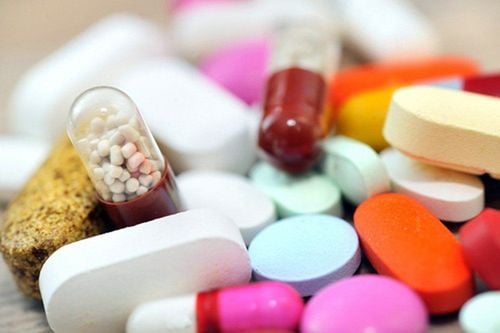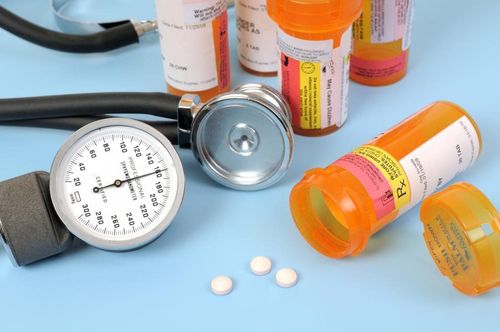This is an automatically translated article.
Tiphagliptin 50 is made in the form of tablets, with the main ingredient being Sitagliptin. The drug is used in the treatment of hyperglycemia in patients with type 2 diabetes.
1. What is Tipagliptin?
What is Tipagliptin? 1 tablet of Tiphagliptin 50 has the main ingredient is 50mg of Sitagliptin (as Sitagliptin phosphate monohydrate). Sitagliptin belongs to a class of oral medications used to treat high blood sugar, called dipeptidyl peptidase 4 (DPP-4) inhibitors, that improve blood sugar in people with type 2 diabetes by increasing levels of the active hormone incretin . These incretin hormones are components of the endogenous system, involved in the physiological regulation of glucose homeostasis.
By increasing concentrations of the active form incretin, Sitagliptin increases insulin release, while decreasing glucagon levels in a glucose-dependent manner. In patients with type 2 diabetes with hyperglycemia, these alterations in insulin and glucagon levels lead to decreased hemoglobin A1c (HbA1c) and postprandial/fasting glucose concentrations.
Indications for use of Tiphagliptin 50
Treatment alone or in combination with other drugs such as hypoglycemic sulphonamides, metformin, PPARy agonists to improve glycemic control in patients with type 2 diabetes. Contraindications to use Tiphagliptin 50
Patients with hypersensitivity to Sitagliptin or other components of the drug.
2. How to use and dose of Tiphagliptin 50
Usage: Orally. Patients should take the drug with 1 glass of water.
Dosage:
Recommended dose: 100mg/day/time when used as monotherapy or in combination with other antidiabetic drugs (when hungry or full); When Sitagliptin is used in combination with a hypoglycaemic sulphonamide, a lower dose of a hypoglycemic sulfamide may be considered in order to reduce the risk of hypoglycaemia due to the hypoglycemic agent; Patients with renal impairment: Adjust dose of Tipagliptin according to creatinine clearance. Therefore, renal function should be assessed prior to initiation of drug therapy. Specific dosage: Mild renal impairment (Clcr ≥ 50ml/min): No need to change the dose; Moderate renal failure Clcr 30 - 50ml/min): Use a dose of 50mg/time/day; Severe renal failure (Clcr < 30ml/min) or end-stage renal disease requiring peritoneal dialysis/hemodialysis: 25mg once daily. Patients can take Sitagliptin at any time, regardless of the time of hemodialysis. Overdose: In clinical trials in healthy subjects, single doses of sitagliptin up to 800 mg were well tolerated. There is no experience with doses above 800 mg in humans. In multiple-dose studies during the day, no dose-related adverse events have been detected with sitagliptin at 600 mg/day for 10 days or 400 mg/day for 28 days.
In case of an overdose of Tiphagliptin 50, the patient will be applied supportive measures such as removing unabsorbed substances from the gastrointestinal tract, clinical monitoring (including electrocardiogram). ) and supportive treatment when necessary. Sitagliptin may be considered for prolonged hemodialysis if clinically appropriate.
Missed dose: When forgetting to take a dose of Tipagliptin 50, patients should consult their doctor for appropriate advice. Patients should not arbitrarily take the supplement dose without the doctor's permission.
3. Side effects of Tiphagliptin 50
When using Tipagliptin 50, patients may experience some side effects such as:
Common, less dangerous: Headache, diarrhea, abdominal pain, nausea, vomiting, indigestion, nasopharyngitis , angioedema, upper respiratory tract infection, hypoglycemia, fungal dermatitis; Rare, serious: Anaphylaxis or severe skin reactions such as Stevens - Johnson syndrome. Patients should inform their doctor about the side effects encountered when taking Tiphagliptin 50 for advice on the most appropriate treatment and response.
4. Be careful when using Tiphagliptin 50
Before and while taking Tiphagliptin 50, patients should note:
Sitagliptin should not be used in patients with type 1 diabetes or used to treat ketoacidosis in diabetics; Sitagliptin is eliminated by the kidneys. To achieve plasma concentrations of sitagliptin similar to those in subjects with normal renal function, the dose should be reduced in patients with moderate and severe renal impairment, end-stage renal disease requiring hemodialysis/peritoneal dialysis. ; The incidence of hypoglycemia due to hypoglycaemic sulphonamides was increased in patients receiving sitagliptin in combination with a hypoglycemic sulphonamide. Therefore, to reduce the risk of hypoglycaemia due to hypoglycaemic sulphonamides, a reduction in the dose of sulphonamides should be considered; There have been cases of serious hypersensitivity reactions with the use of Sitagliptin. These reactions include angioedema, anaphylaxis, and exfoliative disease (including Stevens-Johnson syndrome). These reactions usually begin to appear during the first 3 months after starting Sitagliptin. If a hypersensitivity reaction is suspected, the patient should discontinue sitagliptin, assess for potential causes, and initiate alternative diabetes treatments; The safety and effectiveness of sitagliptin in pediatric patients under 18 years of age have not been established. In clinical studies, the safety and efficacy of sitagliptin in the elderly (over 65 years of age) were similar to those in younger patients (under 65 years of age). There is no need to adjust the dose according to age. In elderly patients with possible renal impairment, dose adjustment may be required if moderate to severe renal impairment is present; The use of Sitagliptin during pregnancy is not recommended; Sitagliptin is excreted in milk (in animals). It is not known whether sitagliptin is excreted in human milk. Therefore, Sitagliptin should not be used in nursing women; Tipagliptin 50 may cause drowsiness and dizziness in a small number of patients. Therefore, caution should be exercised when using the drug with drivers or machine operators. Using the drug before bed will help reduce the effects of the day.
5. Tiphagliptin 50 . drug interactions
Some drug interactions of Tiphagliptin 50 include:
In drug interaction studies, Sitagliptin did not cause clinical effects on the pharmacokinetics of drugs including: Metformin, simvastatin, warfarin, rosiglitazone, glyburide and oral contraceptives pregnant. Based on these data, Sitagliptin did not inhibit the CYP isoenzymes CYP3A4, 2C8 and 2C9. In addition, Sitagliptin did not inhibit CYP2D6, 1A2, 2C19, 2B6 or induce CYP3A4; Repeated twice-daily dosing of metformin with sitagliptin did not significantly alter the pharmacokinetics of sitagliptin in patients with type 2 diabetes; Concomitant drugs that have no clinical significance on the pharmacokinetics of sitagliptin include: anti-hypercholesterolemic drugs (statins, fibrates, ezetimibe), antiplatelet agents (clopidogrel), non-steroidal anti-inflammatory and analgesics (naproxen). , diclofenac, celecoxib), antihypertensives (beta-blockers, angiotensin receptor blockers, ACE inhibitors, calcium channel blockers, hydrochlorothiazide), antihistamines (cetirizine), proton pump inhibitors (omeprazole) , lansoprazol), erectile dysfunction drugs (sildenafil); Area under the curve and mean peak digoxin concentrations were slightly increased when co-administered with sitagliptin. This increase is not clinically significant. Even so, patients who are taking digoxin should still be monitored. No dose adjustment of sitagliptin or digoxin is recommended; When a single dose of Sitagliptin 100 mg was administered with a single dose of cyclosporin 600 mg, the AUC and Cmax of Sitagliptin were increased. These changes are not clinically significant. No dosage adjustment of sitagliptin is recommended when co-administered with cyclosporin or other p-glycoprotein inhibitors. When using Tiphagliptin 50, patients should strictly follow all instructions given by their doctor on how to use, dose and time to take the drug. This ensures the effective treatment of the disease and significantly reduces the risk of unpredictable complications.
Follow Vinmec International General Hospital website to get more health, nutrition and beauty information to protect the health of yourself and your loved ones in your family.
Please dial HOTLINE for more information or register for an appointment HERE. Download MyVinmec app to make appointments faster and to manage your bookings easily.













